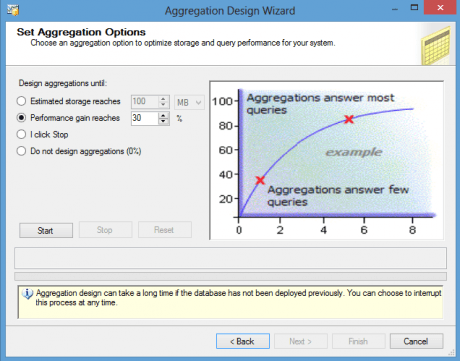- MSBI Career Opportunities
- MSBI Interview Questions
- MSBI Interview Questions
- Action Properties Dialog Box (Report Builder and SSRS) - MSBI
- Best Practices for Performance Tuning in SSAS Cubes
- Conformed Dimension in SSAS with Example
- Data Warehousing Concepts in SSIS
- How To Debug SSIS Packages in SQL Server
- How to Access Report Manager in SSRS 2012
- How to Create Cube in SSAS with Example
- How to Create Drill Down report in SSRS 2008
- How to Create Table Report in Reporting Services - MSBI
- How to Implement Proactive Caching in SSAS - MSBI
- How to Publish Report to a Report Server in SSRS
- Checkpoints in SSIS
- Incremental load in SSIS with example
- Introduction to SQL Server Analysis Services
- Learn to Write MDX Queries in Analysis Services (SSAS)
- MSBI Advantages and Its Data Evaluation Stages - MSBI
- Named Query & Named Calculation in SSAS
- Normalization and T-SQL in SQL Server
- Passing Parameters to a report in SSRS
- Report and Group Variables in Reporting Services - MSBI
- Reporting Services Configuration Files – SSRS
- How to Set Transaction Isolation Level in SQL Server
- SQL Server 2008 R2 – LookUp Enhancement in SSRS
- Partitions In SSAS
- SQL Server Data Modeling
- SQL Server Performance Tuning Tips and Tricks in MSBI
- SQL Server Reporting Services Performance Tuning - MSBI
- SSAS Analysis Services Cube Deployment Methods
- SQL Server Integration Services – SSIS Architecture Overview
- Step by Step MSBI Installation and Requirements - MSBI
- Step by Step SSIS Package Deployment
- TextBox Properties in SSRS 2008
- SSIS Control Flow
- Working with Data Flow Task in SSIS Packages
- Working with Report Models in SSRS
- Working with SSRS Reporting Services Configuration Manager
- T-SQL Interview Questions
Aggregation Design
- Aggregations are precalculated summaries of data from cells.
- Aggregations improve query response time by preparing answers before questions are asked.
- Ex:-When a data warehouse fact table contains millions of vows, a query requisition of the weekly sales totals for a particular product line can take a long time to answer if all the rows in the fact table have to be scanned and summed at query time to compete for the answer.
Learn how to use SQL Server , from beginner basics to advanaced techniques taught by industry Experts Enroll for free SQL Server Training Demo
- Aggregations are stored in the multi-dimensional structure is cells at coordinates specified by the dimensions.
- Depends on storage mode [MOLAP, ROLAP, HOLAP–] and percentage of calculations.
- If 0% aggregations, storage less but query does full scanning and aggregations performed at the cube.

The need for aggregations:
Fact table will more rows, to benefit from long-running queries and instead of doing scanning at leaf levels, aggregations create some level of data, so query processing time will be reduced
What is an aggregation:
It’s a copy of data in your fact table, pre-aggregate to a certain level
- Created when the cube is processed
- Stored on disk
[This result is similar to Group by a statement in SQL Query]
It makes queries fast because it means SSAS does not have to aggregate as much data at query time.
Drawbacks
Aggregations created at processing time, building more aggregations takes more processing time.
Also, increases disk space used by the Cube.
Ex:
Database Explosion
10 20
30 40
10cell 20cell 30cell
30cell 40cell 70cell
40cell 60cell 100cell
5 more aggregations added even though we have 4 values
- Aggregations are useful when the storage engine has to fetch the data from the disk.
- Aggregations will not be used if the data is in the storage engine cache.
- Each Measure group can have 0 or more aggregation design objects.
- Each partition in a group can have 0 or 1 aggregation design objects.
- Run aggregation design wizard to build some aggregations
- Perform usage-based optimization for at least a few weeks, regularly.
Usage-based optimization
Usage-based optimization test you adjust the aggregation design for a measure group by analyzing the queries that have been submitted by client applications.
Aggregations tab → Design Aggregations → Next → Exclude (or) include required objects → Next → click count (Or), manually enter the object counts →
Design aggregations until
Estimated storage reaches 20 MB
Name:-XX – design
Click start → Next →? Deploy and process Now → Finish.
Aggregations → advanced view →
Measure group: Text – Fact Aggregation Design: XXDe.
Storing: Range:
List of Related Microsoft Certification Courses:
| SSIS | Power BI |
| SSRS | SharePoint |
| SSAS | SQL Server DBA |
| SCCM | BizTalk Server |
| Team Foundation Server | BizTalk Server Administrator |
 On-Job Support Service
On-Job Support Service
Online Work Support for your on-job roles.

Our work-support plans provide precise options as per your project tasks. Whether you are a newbie or an experienced professional seeking assistance in completing project tasks, we are here with the following plans to meet your custom needs:
- Pay Per Hour
- Pay Per Week
- Monthly
| Name | Dates | |
|---|---|---|
| MSBI Training | Jan 03 to Jan 18 | View Details |
| MSBI Training | Jan 06 to Jan 21 | View Details |
| MSBI Training | Jan 10 to Jan 25 | View Details |
| MSBI Training | Jan 13 to Jan 28 | View Details |

Ravindra Savaram is a Technical Lead at Mindmajix.com. His passion lies in writing articles on the most popular IT platforms including Machine learning, DevOps, Data Science, Artificial Intelligence, RPA, Deep Learning, and so on. You can stay up to date on all these technologies by following him on LinkedIn and Twitter.
















